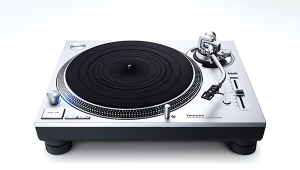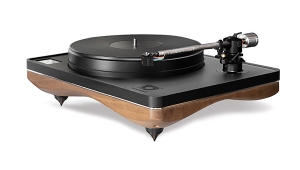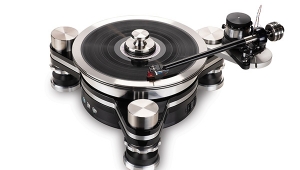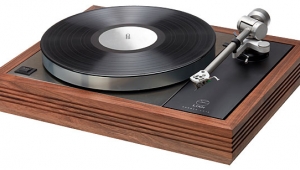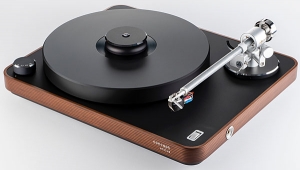| Columns Retired Columns & Blogs |
Rega P3-24, RB301, & Elys 2 turntable, tonearm, & phono cartridge
It's now been eight years since a Rega P3 turntable passed through my listening room. While the new P3-24 superficially resembles the P3 (and virtually every other Rega 'table), the company has made some significant changes, including upgrading to the high-quality, low-voltage (24V), electronically adjusted motor used in the more expensive P5, P7, and P9. As in those models, an electronic circuit trims the phase angle of the P3-24's motor coils, thus substantially reducing motor vibrations. In 1998, during a factory tour, a Rega engineer demonstrated the circuit's effectiveness to me. As he adjusted the circuit board's pot, vibrations from the motor dramatically decreased, until it was difficult to tell if the motor was spinning or not. Back then, this "hand-trimmed" motor technology was available only in the P9. The P3-24 uses a less sophisticated version of the same basic idea.

Given that Rega mounts its motor assemblies to the plinth, the importance of this upgrade cannot be overstated. While an elastomer-suspended motor design like the ingenious one Pro-Ject uses in its least expensive 'tables can lower noise and reduce the amount of vibrational energy transmitted to the plinth, the tradeoff is a motor free to vibrate—and thus move—in space. The small but constantly varying distance between motor and platter causes the drive belt to flex, which makes the platter's rotational speed erratic. Such a design tradeoff is a worthwhile one in a budget 'table, but with the addition of the phase-angle trim circuit to the P3-24, Rega gets rigidity, speed stability, and low noise.
The P3-24's plinth—a slimmed-down, lower-mass version of the P3's—is made of a wood composite. Adding a phenolic-resin laminate on both sides and high-quality edging offers increased rigidity and a more attractive appearance. Like other Regas, the P3-24 sits on three rubber feet.
Rega's new RB301 arm features the rigid, more secure, three-point mount found in their RB700 and flagship RB1000 arms, as well as the improved vertical bearing housing and magnetic antiskating mechanism used in the RB700. The bearing tolerances have been improved over the original RB300 and the arm features higher-quality cables and RCA plugs.
As many readers know, at the dawn of the Compact Disc era, Rega daringly decided to invest a great deal of money in an expensive casting that allowed the company to manufacture a rigid, one-piece, aluminum-alloy tonearm that forms the basis of the arms used in all Rega turntables, and OEM'd to other companies worldwide. The investment has paid off handsomely, but recently Rega had to remake the outer tool, called the bolster, which had finally worn out after casting more than "300-and-something thousand" tonearms, according to Rega's founder, the always-candid Roy Gandy. Thanks to computerized CNC machining, producing the new tool was actually less expensive in 2007 than it had been in the early '80s. A smaller inner tool, the insert, had been replaced four times during the original bolster's lifespan of 25 or so years. Gandy also told me that the tool used for making the plastic dustcover had also finally worn out and had to be remade.
The TT PSU, an optional outboard power supply originally developed for the Rega P7 turntable, produces a stable voltage, synthesized by a quartz oscillator, that drives the motor more precisely. It also permits convenient pushbutton selection of the P3-24's two speeds (33 and 45rpm). It's not retrofittable to the original P3, unfortunately.
Gandy told me that the TT PSU offers a "small improvement" that can't be quantified. "It's not enormous," he admitted, adding that the better the incoming electricity, the less noticeable will be the sonic improvement. The new P3-24 uses the P3's drive system, which comprises a brass bearing well, a steel bearing and ball, an O-ring–driven molded hub, and a glass platter assembly 11.6" in diameter, with a felt mat sitting on top.
When asked if his company has seen evidence of the vinyl resurgence, Gandy replied, "Absolutely. But it's not just vinyl, it's two-channel audio in general." He then threw some water on the fire: "It's not a worldwide consumer return; the market is quite small."
Gandy told me that production problems had recently caused Rega to consolidate its two factories into a single operation. Previously, tonearm and turntable assembly took place in Rega's original factory (where I built an RB300 arm I hope you didn't buy), while electronics and loudspeaker assembly occurred in a bigger, newer facility.
Turntable sales "have not increased dramatically," Gandy told me, but "they've increased very slowly over about the last 10 years. Each year, there's a very definite increase." But that was after the big sales trough of 1991. "It was laid low for about five years," said Gandy, "then began increasing, almost imperceptibly at first, and I think for the last 10 years it's increased at a rate which I think is purely down to us. If we can make slightly new models, different finish, as long as we do it competently and well, the sales are absolutely there."
The P3-24 Sounds Off Smartly
Despite the exchange-rate disadvantage, the P3-24's price of $895 with tonearm is more than competitive. Add a Rega Elys 2 moving-magnet cartridge and the plug'n'play combo will set you back $1095, which represents a $95 discount (sold separately, the Elys 2 goes for $295). Add another $375 for the TT PSU external power supply and the total price of the LP player, as reviewed, is $1470 (about $200 in 1960 dollars).
- Log in or register to post comments
